
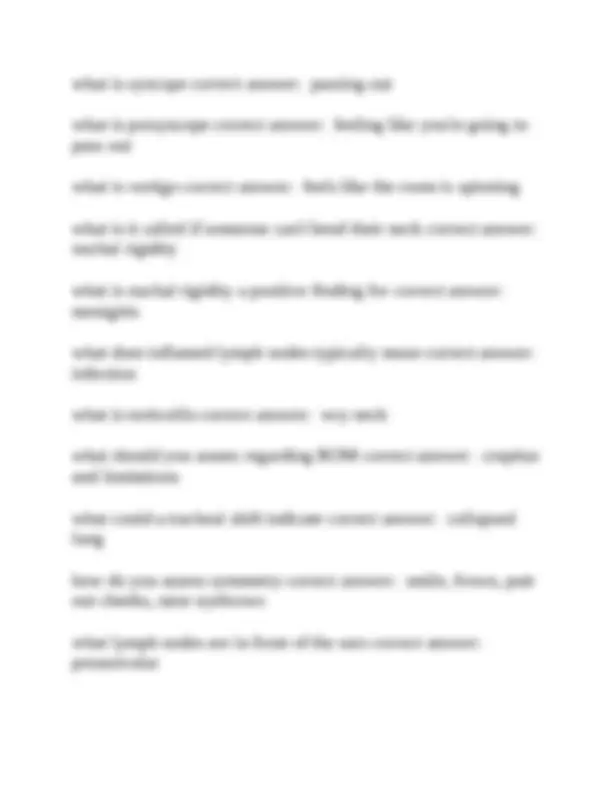
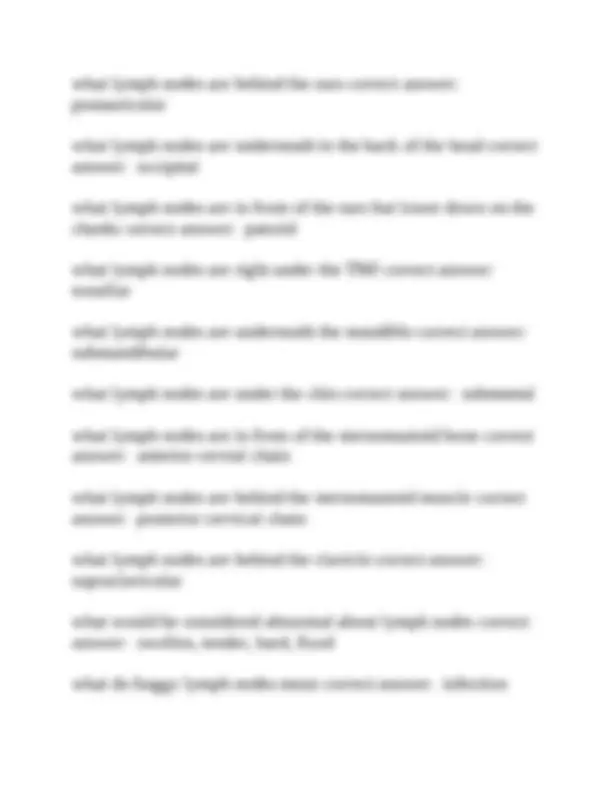
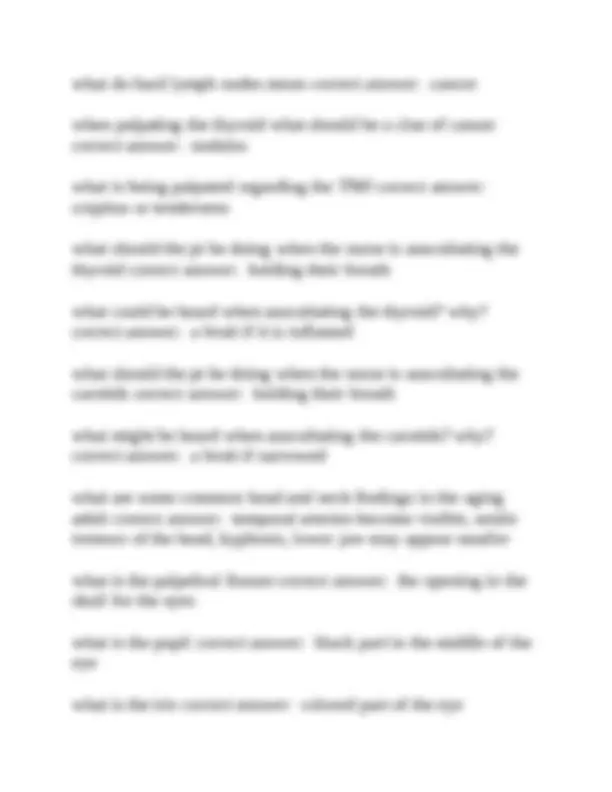

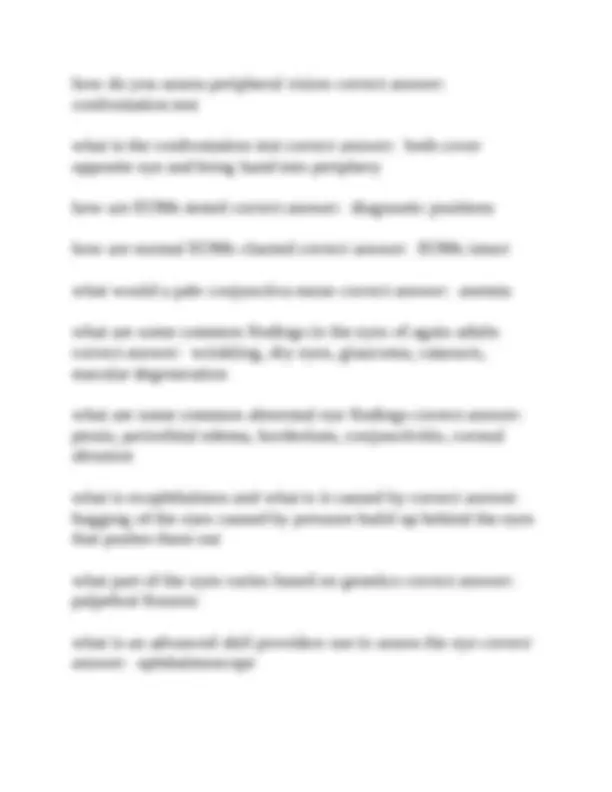
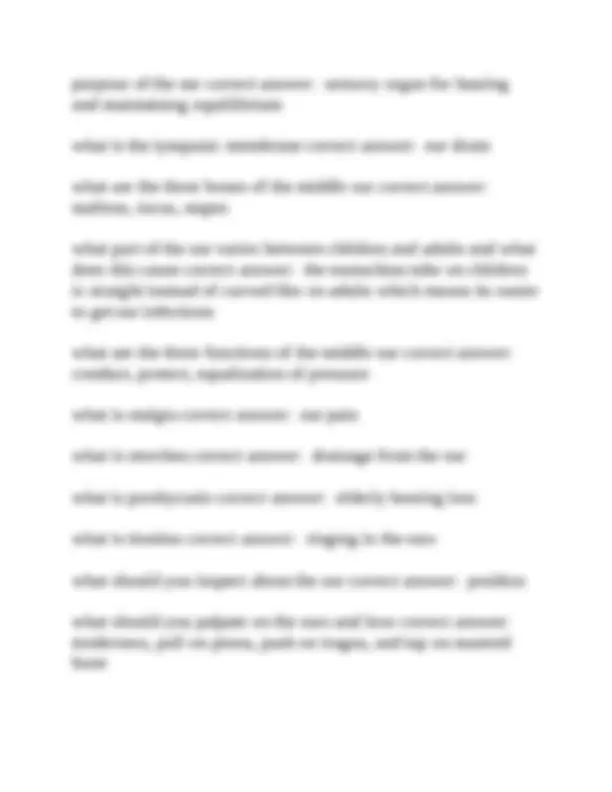
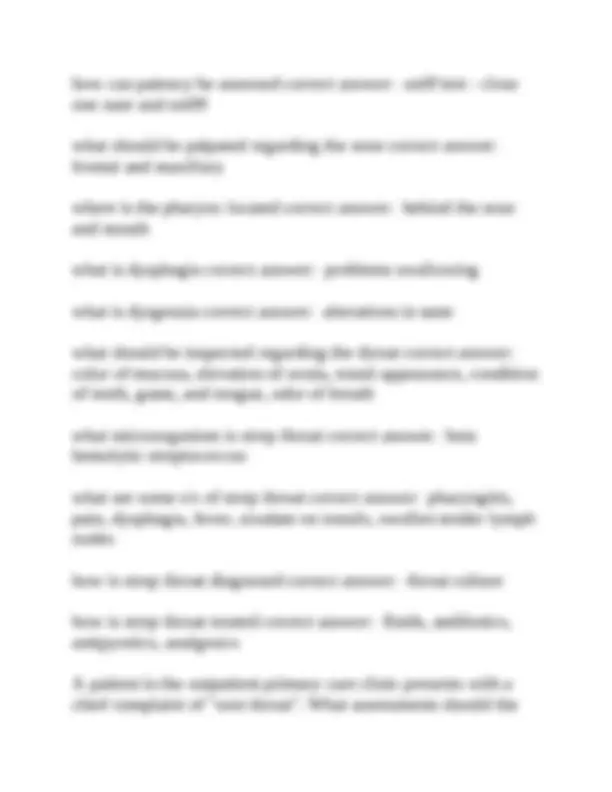
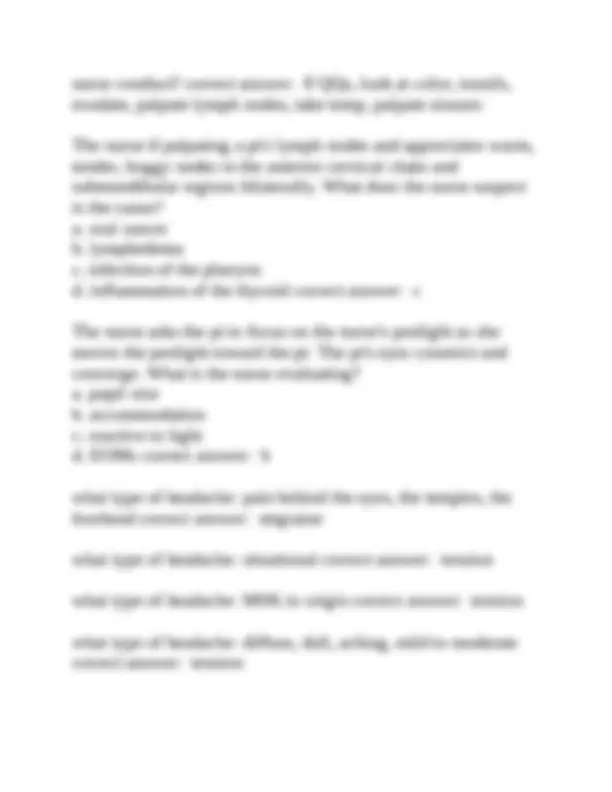
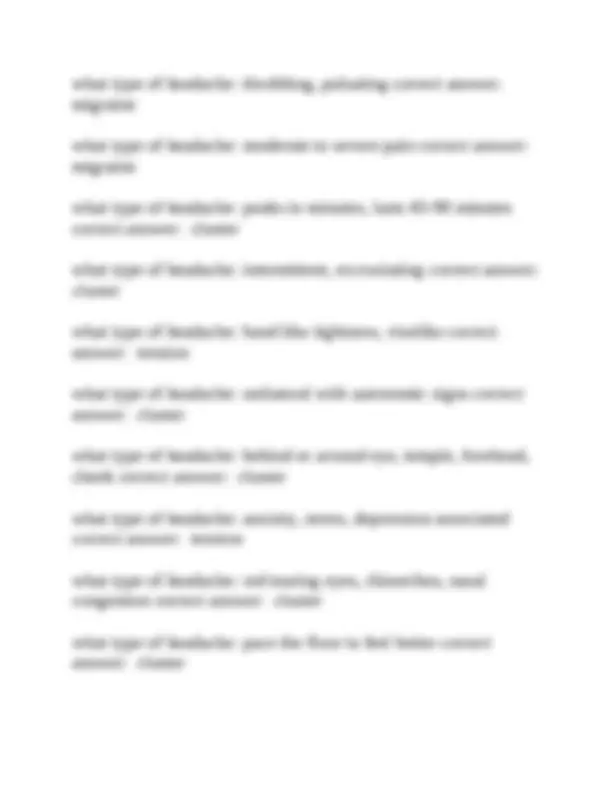


Study with the several resources on Docsity

Earn points by helping other students or get them with a premium plan


Prepare for your exams
Study with the several resources on Docsity

Earn points to download
Earn points by helping other students or get them with a premium plan
Community
Ask the community for help and clear up your study doubts
Discover the best universities in your country according to Docsity users
Free resources
Download our free guides on studying techniques, anxiety management strategies, and thesis advice from Docsity tutors
A comprehensive set of questions and answers related to the head, eyes, ears, nose, and throat (heent) examination, covering key anatomical structures, functions, and common findings. It is a valuable resource for nursing students preparing for exams or clinical practice, offering insights into the assessment and diagnosis of heent conditions.
Typology: Exams
1 / 17

This page cannot be seen from the preview
Don't miss anything!










what are the three salivary glands correct answer: parotid, submandibular, sublingual where is the parotid gland correct answer: back of the cheek where is the submandibular gland correct answer: under the jaw where is the sublingual gland correct answer: under the tongue is the mandible or maxilla stationary correct answer: maxilla what is the zygomatic bone correct answer: cheekbone where should the trachea and esophagus be correct answer: midline what type of gland is the thyroid correct answer: endocrine where is the thyroid correct answer: in front of the trachea what does the thyroid do correct answer: helps control metabolism what does the trapezius do correct answer: move shoulders up and down
what does the sternomastoid muscle do correct answer: turns the head what is the clavicle correct answer: collar bone what is at the top of the manubrium correct answer: suprasternal notch what does the lymphatic system do correct answer: detects and eliminates foreign substances to keep them from entering the blood stream how many lymph nodes are there in just the head and neck correct answer: 60- should the lymph nodes be palpable correct answer: no where can lymph nodes be assessed correct answer: head, neck, arms, axillae, inguinal region where should you assess if you find enlarged lymph nodes correct answer: the area proximal what system are lymphatics apart of correct answer: immune if someone says "this is the worst headache I've ever had in my life" what could this indicate correct answer: intracerebral bleed what does a history of concussions put someone at risk for correct answer: bleed
what lymph nodes are behind the ears correct answer: postauricular what lymph nodes are underneath in the back of the head correct answer: occipital what lymph nodes are in front of the ears but lower down on the cheeks correct answer: patorid what lymph nodes are right under the TMJ correct answer: tonsillar what lymph nodes are underneath the mandible correct answer: submandibular what lymph nodes are under the chin correct answer: submental what lymph nodes are in from of the sternomastoid bone correct answer: anterior cervial chain what lymph nodes are behind the sternomastoid muscle correct answer: posterior cervical chain what lymph nodes are behind the clavicle correct answer: supraclavicular what would be considered abnormal about lymph nodes correct answer: swollen, tender, hard, fixed what do boggy lymph nodes mean correct answer: infection
what do hard lymph nodes mean correct answer: cancer when palpating the thyroid what should be a clue of cancer correct answer: nodules what is being palpated regarding the TMJ correct answer: crepitus or tenderness what should the pt be doing when the nurse is auscultating the thyroid correct answer: holding their breath what could be heard when auscultating the thyroid? why? correct answer: a bruit if it is inflamed what should the pt be doing when the nurse is auscultating the carotids correct answer: holding their breath what might be heard when auscultating the carotids? why? correct answer: a bruit if narrowed what are some common head and neck findings in the aging adult correct answer: temporal arteries become visible, senile tremors of the head, kyphosis, lower jaw may appear smaller what is the palpebral fissure correct answer: the opening in the skull for the eyes what is the pupil correct answer: black part in the middle of the eye what is the iris correct answer: colored part of the eye
what is strabismus correct answer: cross eyed what is diplopia correct answer: double vision what is conjuncitivitis correct answer: redness of the eye what is lacrimation of the eye correct answer: tearing or watering what are cataracts correct answer: clouding of the lens what is glaucoma correct answer: pressure in the eyes what is PERRLA correct answer: pupils round reactive to light and accomodation what is the Snellen test correct answer: close one eye and read chart from 20 feet away what is the near vision test correct answer: hold card 14 in from face and read lines what is ptosis correct answer: droopy eyelid what is periorbital edema correct answer: edema around the eyes what is scleral icterus correct answer: scleral jaundice what is cornal abrasion correct answer: abrasion to the cornea, possibly caused by leaving contact in too long
what is mydriasis correct answer: blown pupils what is miosis of the eye correct answer: pinpoint pupils what is aniscoria correct answer: unequal pupil size what are fixed pupils correct answer: not reactive to light or no convergence what is myopia correct answer: near vision what is hyperopia correct answer: far vision what is presbyopia correct answer: visual changing due to aging what is nystagmus correct answer: eyes vibrate back and forth what is extropion correct answer: eyelids turn outwards what is entropion correct answer: eyelids turn inward what do the two numbers of the snellen test results mean correct answer: first number is the distance the pt can read at, second is the average person how do you assess color blindness correct answer: ishihara test is color blindness acquired or genetic correct answer: genetic
purpose of the ear correct answer: sensory organ for hearing and maintaining equiilibrium what is the tympanic membrane correct answer: ear drum what are the three bones of the middle ear correct answer: malleus, incus, stapes what part of the ear varies between children and adults and what does this cause correct answer: the eustachian tube on children is straight instead of curved like on adults which means its easier to get ear infections what are the three functions of the middle ear correct answer: conduct, protect, equalization of pressure what is otalgia correct answer: ear pain what is otorrhea correct answer: drainage from the ear what is presbycusis correct answer: elderly hearing loss what is tinnitus correct answer: ringing in the ears what should you inspect about the ear correct answer: position what should you palpate on the ears and how correct answer: tenderness, pull on pinna, push on tragus, and tap on mastoid bone
how do you test for auditory acuuity correct answer: whisper test how do you administer the whisper test correct answer: stand 2 ft behind pt, pt closes one ear, whisper three words and have pt repeat them how do you document whisper test results correct answer: number of words/3 at ft for each ear what are the two types of hearing loss correct answer: conductive and sensorineural what is conductive hearing loss correct answer: mechanical issue like bones not working or foreign body what is sensorineural hearing loss correct answer: perceptive problem like auditory nerve isn't working what are some advanced techniques providers use to inspect the ears correct answer: otoscope to visualize the TM what are turbinates correct answer: ridges in the nose that increase surface area what gives mucous membranes their red appearance correct answer: the rich blood supply what is the most common site of nosebleeds correct answer: kisselbach plexus
how can patency be assessed correct answer: sniff test - close one nare and snifff what should be palpated regarding the nose correct answer: frontal and maxillary where is the pharynx located correct answer: behind the nose and mouth what is dysphagia correct answer: problems swallowing what is dysgeusia correct answer: alterations in taste what should be inspected regarding the throat correct answer: color of mucosa, elevation of uvula, tonsil appearance, condition of teeth, gums, and tongue, odor of breath what microorganism is strep throat correct answer: beta hemolytic streptococcus what are some s/s of strep throat correct answer: pharyngitis, pain, dysphagia, fever, exudate on tonsils, swollen tender lymph nodes how is strep throat diagnosed correct answer: throat culture how is strep throat treated correct answer: fluids, antibiotics, antipyretics, analgesics A patient in the outpatient primary care clinic presents with a chief complaint of "sore throat". What assessments should the
nurse conduct? correct answer: 8 QQs, look at color, tonsils, exudate, palpate lymph nodes, take temp, palpate sinuses The nurse if palpating a pt's lymph nodes and appreciates warm, tender, boggy nodes in the anterior cervical chain and submandibular regions bilaterally. What does the nurse suspect is the cause? a. oral cancer b. lymphedema c. infection of the pharynx d. inflammation of the thyroid correct answer: c The nurse asks the pt to focus on the nurse's penlight as she moves the penlight toward the pt. The pt's eyes constrict and converge. What is the nurse evaluating? a. pupil size b. accommodation c. reactive to light d. EOMs correct answer: b what type of headache: pain behind the eyes, the temples, the forehead correct answer: migraine what type of headache: situational correct answer: tension what type of headache: MSK in origin correct answer: tension what type of headache: diffuse, dull, aching, mild to moderate correct answer: tension
what type of headache: can be situational, over work, posture correct answer: tension what type of headache: n/v/photophobia correct answer: migraine what type of headache: vascular origin correct answer: migraine what type of headache: peaks in 1-2 hours, lasts 4-72 hours correct answer: migraine what type of headache: severe stabbing pain correct answer: cluster what type of headache: associated with family history correct answer: migraine what type of headache: prodromal symptoms (aura) correct answer: migraine what type of headache: alcohol, stress, daytime napping, wind, or heat can be triggers correct answer: cluster what type of headache: abrupt onset, peaks in minutes correct answer: cluster what type of headache: gradual onset correct answer: tension what type of headache: triggered by hormones, ETOH, caffeine, chocolate, cheese, perfumes correct answer: migraine
what type of headache: usually both sides tend to be frontal, temporal, and/or occipital region correct answer: tension what type of headache: rapid onset, peaks in 1-2 hours correct answer: migraine what type of headache: lie down, seek quiet dark place correct answer: migraine what type of headache: worse with physical activity correct answer: migraine what type of headache: not disabling can have remission for months to years correct answer: cluster what type of headache: can occur multiple times per day correct answer: cluster